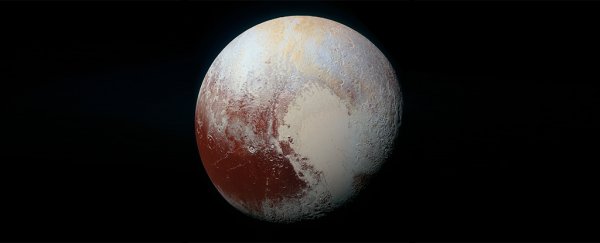It's only been in recent years - since the historic flyby of the New Horizons probe in 2015 - that we've been able to understand Pluto with any great depth or detail. We've learnt a lot about our Solar System's tiny outlier, but one of the biggest surprises was a number of hints that liquid oceans still slosh beneath Pluto's icy surface.
At an average distance of 5.9 billion kilometres (3.7 billion miles) from the Sun, in the frigid reaches of the Kuiper Belt, scientists had thought the dwarf planet must have been frozen solid - and exactly how liquid water could exist on such a cold object was a mystery.
Now astronomers have come up with a new scenario, detailed in a new paper - if Pluto formed quickly, the heat generated by this process could have been sufficient to keep subsurface oceans liquid for billions of years.
"For a long time people have thought about the thermal evolution of Pluto and the ability of an ocean to survive to the present day," said Earth and planetary scientist Francis Nimmo of the University of California Santa Cruz.
"Now that we have images of Pluto's surface from NASA's New Horizons mission, we can compare what we see with the predictions of different thermal evolution models."
Pluto, which formed around 4.5 billion years ago with the rest of the Solar System, could have accreted more slowly, from cold material. Under this model, different mechanisms could account for the liquid subsurface water, such as the decay of radioactive elements in Pluto's core.
However, while this cold-start model is a plausible way for liquid water to persist in a Kuiper Belt object, it is inconsistent with some of the features discovered on Pluto's surface through New Horizons observations.
"If it started cold and the ice melted internally, Pluto would have contracted and we should see compression features on its surface, whereas if it started hot it should have expanded as the ocean froze and we should see extension features on the surface," said Earth and planetary scientist Carver Bierson of UC San Diego, lead author on the paper.
"We see lots of evidence of expansion, but we don't see any evidence of compression, so the observations are more consistent with Pluto starting with a liquid ocean."
 Extensional faults on Pluto's surface. (NASA/JHUAPL/SwRI/Alex Parker)
Extensional faults on Pluto's surface. (NASA/JHUAPL/SwRI/Alex Parker)
You see, the presence of extension lines alone is not a smoking gun for a hot-start scenario. If Pluto started out hot, the dwarf planet would undergo an early, rapid extension phase for about 1 billion years, followed by a longer, slower extension phase of about 3.5 billion years.
But in a cold-start scenario, the second phase would also be extensional; the difference is that the earlier phase would be compressional. Hence, to figure out which story fits, it's important to figure out early-phase features - which is what the team has done, identifying a system of ridges and troughs they believe are indicative of an early extensional phase.
"The oldest surface features on Pluto are harder to figure out, but it looks like there was both ancient and modern extension of the surface," Nimmo said.
The next step was to model how Pluto could have started out hot from the beginning. One source of such heat energy would be the accretion process - material raining down on Pluto to add to its growing bulk. As this material impacts, it imparts gravitational energy, which is then released as heat.
But the timescales on which this occurs makes a big difference.
"How Pluto was put together in the first place matters a lot for its thermal evolution," Nimmo said. "If it builds up too slowly, the hot material at the surface radiates energy into space, but if it builds up fast enough the heat gets trapped inside."
Traditional models for Kuiper Belt objects would see this process take hundreds of millions of years to produce an object the size of Pluto, 2,376 kilometres (1,476 miles) in diameter. That's way too slow; Pluto would be cold before it could even start to cook.
But recent research has suggested a new formation model - a multi-stage process in which a planetesimal grows relatively slowly to about 300 kilometres across, and the final accretion stage occurs rapidly.
Under this scenario, Pluto could form in around 30,000 years - the time the team calculated it would take for the hot-start model. And, the researchers note, their results imply that other large Kuiper Belt objects could have started out hot, and also had early oceans.
It's only hypothetical at this stage, but there are features that could confirm the team's ideas.
"One important distinction between the cold start and hot start models is that the former, but not the latter, is likely to retain an undifferentiated, rock-rich carapace in the near-surface … clear evidence of a rock-rich carapace, such as that inferred at Ceres, would rule out a hot start Pluto," the researchers wrote in their paper.
"Similarly, widespread evidence of compressional features such as wrinkle ridges would be very hard to reconcile with a hot start Pluto. … The main prerequisite for any of these tests is a stratigraphic column for Pluto; now that the basic cratering characteristics have been established, such an enterprise can be attempted."
The research has been published in Nature Geoscience.
